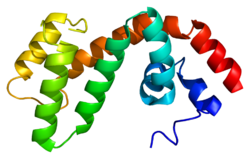RGS17
| Regulator G proteinske signalizacije 17 | |||||||||||
|---|---|---|---|---|---|---|---|---|---|---|---|
 | |||||||||||
| Dostupne strukture | |||||||||||
| 1zv4 | |||||||||||
| Identifikatori | |||||||||||
| Simboli | RGS17; RGS-17; RGSZ2; hRGS17 | ||||||||||
| Vanjski ID | OMIM: 607191 MGI: 1927469 HomoloGene: 8242 GeneCards: RGS17 Gene | ||||||||||
| |||||||||||
| Pregled RNK izražavanja | |||||||||||
 | |||||||||||
| podaci | |||||||||||
| Ortolozi | |||||||||||
| Vrsta | Čovek | Miš | |||||||||
| Entrez | 26575 | 56533 | |||||||||
| Ensembl | ENSG00000091844 | ENSMUSG00000019775 | |||||||||
| UniProt | Q9UGC6 | Q6P208 | |||||||||
| RefSeq (mRNA) | NM_012419 | NM_019958 | |||||||||
| RefSeq (protein) | NP_036551 | NP_064342 | |||||||||
| Lokacija (UCSC) |
Chr 6: 153.37 - 153.49 Mb |
Chr 10: 4.42 - 4.51 Mb | |||||||||
| PubMed pretraga | [1] | [2] | |||||||||
Regulator G proteinske signalizacije 17 (RGS17) je protein koji je kod čoveka kodiran RGS17 genom.[1][2]
Ovaj gen kodira člana regulatorne G-proteinske signalne familije. Ovaj protein sadrži konzervirani motiv od 120 aminokiselina koji se naziva RGS domen, i cisteinom bogati region. On prigušuje signalnu aktivnost G-proteina vezivanjem za aktiviranu, GTP-vezanu G alfa podjedinicu i delujući kao aktivirajući protein GTPaze (GAP), čime povišava brzinu GTP konverzije do GDP-a. Ova hidroliza omogućava G alfa podjedinicama da se vežu za G beta/gama heterodimere, formirajući neaktivne G-proteinske heterotrimere, čime se zaustavlja signal.[2] Zajedno sa RGS4, RGS9 i RGS14,[3][4] RGS17 učestvuje u terminaciji signalizacije mi opioidnog receptora i razvoju tolerancije na opioidne analgetike.[5][6]
Reference
[уреди | уреди извор]- ^ Jordan JD, Carey KD, Stork PJ, Iyengar R (1999). „Modulation of rap activity by direct interaction of Galpha(o) with Rap1 GTPase-activating protein”. J Biol Chem. 274 (31): 21507—10. PMID 10419452. doi:10.1074/jbc.274.31.21507.
- ^ а б „Entrez Gene: RGS17 regulator of G-protein signalling 17”.
- ^ Garzón J, Rodríguez-Muñoz M, de la Torre-Madrid E, Sánchez-Blázquez P (2005). „Effector antagonism by the regulators of G protein signalling (RGS) proteins causes desensitization of mu-opioid receptors in the CNS”. Psychopharmacology. 180 (1): 1—11. PMID 15830230. doi:10.1007/s00213-005-2248-9.
- ^ Rodríguez-Muñoz M, de la Torre-Madrid E, Gaitán G, Sánchez-Blázquez P, Garzón J (2007). „RGS14 prevents morphine from internalizing Mu-opioid receptors in periaqueductal gray neurons”. Cellular Signalling. 19 (12): 2558—71. PMID 17825524. doi:10.1016/j.cellsig.2007.08.003.
- ^ Garzón J, Rodríguez-Muñoz M, López-Fando A, Sánchez-Blázquez P (2005). „The RGSZ2 protein exists in a complex with mu-opioid receptors and regulates the desensitizing capacity of Gz proteins”. Neuropsychopharmacology : Official Publication of the American College of Neuropsychopharmacology. 30 (9): 1632—48. PMID 15827571. doi:10.1038/sj.npp.1300726.
- ^ Rodríguez-Muñoz M, de la Torre-Madrid E, Sánchez-Blázquez P, Garzón J (2007). „Morphine induces endocytosis of neuronal mu-opioid receptors through the sustained transfer of Galpha subunits to RGSZ2 proteins”. Molecular Pain. 3: 19. PMC 1947952
 . PMID 17634133. doi:10.1186/1744-8069-3-19.
. PMID 17634133. doi:10.1186/1744-8069-3-19.
Literatura
[уреди | уреди извор]- Gerhard DS; Wagner L; Feingold EA; et al. (2004). „The status, quality, and expansion of the NIH full-length cDNA project: the Mammalian Gene Collection (MGC).”. Genome Res. 14 (10B): 2121—7. PMC 528928
 . PMID 15489334. doi:10.1101/gr.2596504.
. PMID 15489334. doi:10.1101/gr.2596504. - Mao H; Zhao Q; Daigle M; et al. (2004). „RGS17/RGSZ2, a novel regulator of Gi/o, Gz, and Gq signaling.”. J. Biol. Chem. 279 (25): 26314—22. PMID 15096504. doi:10.1074/jbc.M401800200.
- Larminie C; Murdock P; Walhin JP; et al. (2004). „Selective expression of regulators of G-protein signaling (RGS) in the human central nervous system.”. Brain Res. Mol. Brain Res. 122 (1): 24—34. PMID 14992813. doi:10.1016/j.molbrainres.2003.11.014.
- Mungall AJ; Palmer SA; Sims SK; et al. (2003). „The DNA sequence and analysis of human chromosome 6.”. Nature. 425 (6960): 805—11. PMID 14574404. doi:10.1038/nature02055.
- Fischer T, De Vries L, Meerloo T, Farquhar MG (2003). „Promotion of G alpha i3 subunit down-regulation by GIPN, a putative E3 ubiquitin ligase that interacts with RGS-GAIP.”. Proc. Natl. Acad. Sci. U.S.A. 100 (14): 8270—5. PMC 166218
 . PMID 12826607. doi:10.1073/pnas.1432965100.
. PMID 12826607. doi:10.1073/pnas.1432965100. - Strausberg RL; Feingold EA; Grouse LH; et al. (2003). „Generation and initial analysis of more than 15,000 full-length human and mouse cDNA sequences.”. Proc. Natl. Acad. Sci. U.S.A. 99 (26): 16899—903. PMC 139241
 . PMID 12477932. doi:10.1073/pnas.242603899.
. PMID 12477932. doi:10.1073/pnas.242603899. - Sierra DA; Gilbert DJ; Householder D; et al. (2002). „Evolution of the regulators of G-protein signaling multigene family in mouse and human.”. Genomics. 79 (2): 177—85. PMID 11829488. doi:10.1006/geno.2002.6693.

